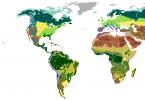Type of protozoa
Sarcomastigophores
Sarcode
Proteus amoeba (common), dysenteric amoeba, radiolaria
Flagella
Euglena green, Volvox, African trypanosoma, Leishmania, Trichomonas, Giardia hepatic
spores
coccidiae
Malarial Plasmodium
ciliates
Eyelash
Infusoria-balantidia, infusoria-shoe, infusoria-trumpeter
Trichofriosis
Used Books:
1.Biology: complete reference to prepare for the exam. / G.I. Lerner. - M.: AST: Astrel; Vladimir; VKT, 2009 2. Biology: Animals: textbook. for 7-8 cells. general education institutions. - 7th ed. - M.: Education, 2000. 3. Biology: study guide / A.G. Lebedev. M.: AST: Astrel. 2009. 4. Biology. Full course of general education high school: tutorial for schoolchildren and entrants / M.A.Valovaya, N.A.Sokolova, A.A. Kamensky. - M.: Exam, 2002. 5. Biology for university applicants. Intensive course / G.L. Bilich, V.A. Kryzhanovsky. - M.: Onyx Publishing House, 2006.
Used Internet resources:
The sub-kingdom of Unicellular, or Protozoa, includes animals whose body consists of one cell. The size of the simplest is on average 0.1-0.5 mm. There are individuals of even smaller size - about 0.01 mm. There are also quite large organisms, several millimeters and even centimeters long.
inhabit protozoan unicellular animals predominantly in a liquid environment - in the sea and fresh water, moist soil, in other organisms. Outwardly, they are very diverse. Some resemble shapeless gelatinous lumps (for example, amoeba), others have a geometrically regular shape (for example, ray).
Protozoa has about 30 thousand species.
The structure of ciliates shoe and amoeba

The structure of euglena green

Table signs of protozoa unicellular animals
|
Signs of the simplest unicellular |
amoeba vulgaris (Class Rootlegs) |
Euglena green (class Flagellates) |
Infusoria Tu-felk (Infusoria class) |
|
Structure |
Consists of cytoplasm, nucleus, contractile vacuole, pseudopod, digestive vacuole (see fig.) |
Consists of a shell, nucleus, flagellum, eye, contractile vacuole, nutrients, chloroplasts (see fig.) |
Consists of a membrane, small and large nuclei, contractile and digestive vacuoles, mouth, powder, cilia (see fig.) |
|
Traffic |
"Flowing" with the help of pseudopods |
Locomotion with a flagellum |
Locomotion with cilia |
|
Food can be bacteria, microscopic algae. The amoeba captures food by extending pseudopods anywhere on the body. They envelop the prey and, together with a small amount of water, immerse it in the cytoplasm. This is how the digestive vacuole is formed - phagocytosis, the capture of liquid drops - pinocytosis. From the digestive vacuole, soluble products of digestion enter the cytoplasm, and undigested residues are excreted from the body in any part of the cell. |
Autotrophic (photo-synthesis) or heterotrophic (phagocytosis and pinocytosis) |
They feed on various microorganisms, mainly bacteria. The movement of the cilia located along the oral cavity drives the prey into it. Together with water, it enters the cellular mouth, then into the pharynx. A digestive vacuole is formed, undigested residues are ejected through the powder. |
|
|
Reproduction |
The amoeba reproduces by division. In this case, the nucleus is divided in two. The newly formed nuclei diverge to the sides, and a transverse constriction appears between them, dividing the amoeba into two daughter cells that live independently. After some time, young amoeba also begin to divide. For reproduction, the water temperature is about +20 °C. |
The reproduction of organisms of this species of euglena is asexual - by dividing the cell in half, in contrast to the infusoria-shoe, which is also characterized by the sexual process. |
Ciliates reproduce asexually - by transverse division, like amoeba. The small nucleus is divided into two first, then the large one. At the same time, a transverse constriction appears. She eventually divides the ciliates into two young (daughter) cells. They grow and, with good nutrition and optimal temperature, the next day they become adults and can divide again. For ciliates, the sexual process is also characteristic in the form conjugations(fusion of two cells and exchange of genetic information) |
_______________
The source of information: Biology in tables and diagrams. / Edition 2e, - St. Petersburg: 2004.
Class Flagella
Structure. Flagellates have flagella that serve as organelles of movement and contribute to the capture of food. There may be one, two or many. The movement of the flagellum in the surrounding water causes a whirlpool, due to which small particles suspended in water are carried away to the base of the flagellum, where there is a small opening - a cellular mouth leading to a deep canal-pharynx.
Almost all flagellates are covered with a dense elastic membrane, which, along with the developed elements of the cytoskeleton, determines the permanent shape of the body.
genetic apparatus
in most flagellates, it is represented by a single nucleus, but there are also binuclear (for example, Giardia) and multinuclear (for example, opal) species.
Cytoplasm
it is clearly divided into a thin outer layer - a transparent ectoplasm and a deeper lying endoplasm.
Nutrition method. According to the method of feeding, flagellates are divided into three groups. Autotrophic organisms, as an exception in the animal kingdom, synthesize organic substances (carbohydrates) from carbon dioxide and water with the help of chlorophyll and the energy of solar radiation. Chlorophyll is found in chromatophores similar in organization to plant plastids. Many flagellates with a vegetable type of nutrition have special apparatuses that perceive light stimuli - stigmas.
Heterotrophic organisms (trypanosoma - the causative agent of sleeping sickness) do not have chlorophyll and therefore cannot synthesize carbohydrates from inorganic substances. Mixotrophic organisms are capable of photosynthesis, but also feed on minerals and organic matter created by other organisms (euglena green).
Osmoregulatory
and partly excretory functions are carried out in flagellates, as in sarcodes, by contractile vacuoles, which are present in free-living freshwater forms.
Reproduction. Flagellates have sexual and asexual reproduction. The usual form of asexual reproduction is longitudinal fission.
Habitat. Flagellates are widely distributed in fresh water bodies, especially small and polluted with organic residues, as well as in the seas. Many species parasitize various animals and humans and thus cause great harm (tryponosomes, intestinal parasites, etc.).
The common features of the organization of protozoa are the following:
Most protozoa are unicellular, rarely colonial organisms. Their unicellular body has the functions of an integral organism, which are performed by general-purpose organelles (nucleus, endoplasmic reticulum, Golgi complex, lysosomes, mitochondria, ribosomes, etc.) and special (digestive and contractile vacuoles, flagella, cilia, etc.). Coordinated functioning, they provide a single cell with the possibility of existence as an independent organism.
Integuments of protozoa are presented either only plasma membrane, or also a dense, rather flexible and elastic shell - pellicle giving them a relative constancy of the shape of the body. Two layers are clearly distinguished in the cytoplasm: superficial, denser - ectoplasm, and internal, more liquid and granular - endoplasm, in which the organelles of the protozoan are located. Due to the colloidal properties of the cytoplasm, these two layers can mutually pass into each other.
Organelles of movement of most species - pseudopods, flagella or numerous short eyelashes.
Freshwater unicellular organisms have 1 -2 contractile vacuoles, whose main function is to maintaining a constant osmotic pressure, carried out for
Irritability at protozoa manifests itself in the form taxis.
Most protozoa have the ability to tolerate unfavourable conditions in a state of resting stage - cysts. In this case, the cell is rounded, draws in or discards the organelles of movement and is covered with a dense protective shell. The cyst stage enables the protozoan not only to survive adverse conditions in an inactive state, but also to settle. Once in favorable conditions, the protozoan leaves the cyst shell and begins to feed and multiply.
The protozoa are subdivided into classes: rhizopods, flagellates, ciliates, spores.
Evolution of unicellular, plant and animal world
Evolution of unicellular organisms
Until the 1950s, it was not possible to detect traces of Precambrian life at the level of single-celled organisms, since the microscopic remains of these creatures cannot be detected by conventional paleontological methods. An important role in their discovery was played by a discovery made at the beginning of the 20th century. C. Walcott. In the Precambrian deposits in the west of North America, he found layered limestone formations in the form of pillars, later called stromatolites. In 1954, it was found that the stromatolites of the Gunflint Formation (Canada) were formed by the remains of bacteria and blue-green algae. Off the coast of Australia, living stromatolites have also been found, consisting of the same organisms and very similar to fossil Precambrian stromatolites. To date, the remains of microorganisms have been found in dozens of stromatolites, as well as in shales of sea coasts.
The earliest of bacteria (prokaryotes) already existed about 3.5 billion years ago. To date, two families of bacteria have survived: ancient, or archeobacteria (halophilic, methane, thermophilic), and eubacteria (all the rest). Thus, the only living beings on Earth for 3 billion years were primitive microorganisms. Perhaps they were single-celled creatures similar to modern bacteria, such as Clostridium, living on the basis of fermentation and the use of energy-rich organic compounds that arise abiogenically under the influence of electrical discharges and ultraviolet rays. Consequently, in this era, living beings were consumers of organic substances, not their producers.
A giant step towards the evolution of life was associated with the emergence of the main biochemical metabolic processes - photosynthesis and respiration, and with the formation of a cellular organization containing a nuclear apparatus (eukaryotes). These "inventions", made in the early stages of biological evolution, have largely survived in modern organisms. Methods of molecular biology have established a striking uniformity of the biochemical foundations of life, with a huge difference in organisms in other ways. The proteins of almost all living things are made up of 20 amino acids. Nucleic acids encoding proteins are assembled from four nucleotides. Protein biosynthesis is carried out according to a uniform scheme, the place of their synthesis is ribosomes, it involves i-RNA and t-RNA. The vast majority of organisms use the energy of oxidation, respiration and glycolysis, which is stored in ATP.
Let us consider in more detail the features of evolution at the cellular level of life organization. The greatest difference exists not between plants, fungi and animals, but between organisms with a nucleus (eukaryotes) and those without it (prokaryotes). The latter are represented by lower organisms - bacteria and blue-green algae (cyanobacteria, or cyanides), all other organisms are eukaryotes, which are similar to each other in intracellular organization, genetics, biochemistry and metabolism.
The difference between prokaryotes and eukaryotes also lies in the fact that the former can live both in anoxic (obligate anaerobes) and in an environment with different oxygen content (facultative anaerobes and aerobes), while for eukaryotes, with a few exceptions, it is mandatory oxygen. All these differences were essential for understanding the early stages of biological evolution.
A comparison of prokaryotes and eukaryotes in terms of oxygen demand leads to the conclusion that prokaryotes arose during a period when the oxygen content in the environment changed. By the time the eukaryotes appeared, the oxygen concentration was high and relatively constant.
The first photosynthetic organisms appeared about 3 billion years ago. These were anaerobic bacteria, the forerunners of modern photosynthetic bacteria. It is assumed that they formed the most ancient known stromatolites. The depletion of the environment with nitrogenous organic compounds caused the appearance of living beings capable of using atmospheric nitrogen. Such organisms that can exist in an environment completely devoid of organic carbon and nitrogen compounds are photosynthetic nitrogen-fixing blue-green algae. These organisms carried out aerobic photosynthesis. They are resistant to the oxygen they produce and can use it for their own metabolism. Since blue-green algae arose during a period when the concentration of oxygen in the atmosphere fluctuated, it is quite possible that they are intermediate organisms between anaerobes and aerobes.
It is strongly suggested that photosynthesis, in which hydrogen sulfide is the source of hydrogen atoms to reduce carbon dioxide (such photosynthesis is carried out by modern green and purple sulfur bacteria), preceded the more complex two-stage photosynthesis, in which hydrogen atoms are extracted from water molecules. The second type of photosynthesis is characteristic of cyanide and green plants.
The photosynthetic activity of primary unicellular organisms had three consequences that had a decisive influence on the entire further evolution of living things. First, photosynthesis freed organisms from competition for natural reserves of abiogenic organic compounds, the number of which in the environment has been significantly reduced. Autotrophic nutrition, which developed through photosynthesis, and the storage of ready-made nutrients in plant tissues then created the conditions for the emergence of an enormous variety of autotrophic and heterotrophic organisms. Secondly, photosynthesis ensured the saturation of the atmosphere with a sufficient amount of oxygen for the emergence and development of organisms whose energy metabolism is based on the processes of respiration. Thirdly, as a result of photosynthesis, an ozone screen was formed in the upper part of the atmosphere, protecting earthly life from the destructive ultraviolet radiation of space,
Another significant difference between prokaryotes and eukaryotes is that in the latter, the central mechanism of metabolism is respiration, while in most prokaryotes, energy metabolism is carried out in fermentation processes. Comparison of the metabolism of prokaryotes and eukaryotes leads to the conclusion about the evolutionary relationship between them. Probably, anaerobic fermentation arose at earlier stages of evolution. After the appearance of a sufficient amount of free oxygen in the atmosphere, aerobic metabolism turned out to be much more profitable, since the oxidation of carbohydrates increases the yield of biologically useful energy by 18 times compared to fermentation. Thus, an aerobic way of extracting energy by unicellular organisms joined the anaerobic metabolism.
When did eukaryotic cells appear? There is no exact answer to this question, but a significant amount of data on fossil eukaryotes allows us to say that their age is about 1.5 billion years. There are two hypotheses regarding how eukaryotes arose.
One of them (the autogenous hypothesis) suggests that the eukaryotic cell arose by differentiation of the original prokaryotic cell. At first, a membrane complex developed: an outer cell membrane was formed with protrusions into the cell, from which separate structures were formed that gave rise to cell organelles. From which group of prokaryotes eukaryotes arose, it is impossible to say.
Another hypothesis (symbiotic) was proposed recently by the American scientist Margulis. In its justification, she put new discoveries, in particular, the discovery of extranuclear DNA in plastids and mitochondria and the ability of these organelles to divide independently. L. Margulis suggests that the eukaryotic cell arose as a result of several acts of symbiogenesis. First, a large amoeboid prokaryotic cell united with small aerobic bacteria, which turned into mitochondria. This symbiotic prokaryotic cell then incorporated spirochete-like bacteria from which kinetosomes, centrosomes, and flagella were formed. After the isolation of the nucleus in the cytoplasm (a sign of eukaryotes), a cell with this set of organelles turned out to be the starting point for the formation of the kingdoms of fungi and animals. The combination of a prokaryotic cell with cyanideans led to the formation of a plastid cell, which gave rise to the formation of the plant kingdom. Margulis's hypothesis is not shared by everyone and is criticized. Most authors adhere to the autogenous hypothesis, which is more in line with the Darwinian principles of monophyly, differentiation and complication of organization in the course of progressive evolution.
In the evolution of a unicellular organization, intermediate steps are distinguished, associated with the complication of the structure of the organism, the improvement of the genetic apparatus and methods of reproduction.
The most primitive stage - agamous prokaryotic - is represented by cyanide and bacteria. The morphology of these organisms is the simplest in comparison with other unicellular (protozoa). However, already at this stage, differentiation into the cytoplasm, nuclear elements, basal grains, and the cytoplasmic membrane appears. In bacteria, the exchange of genetic material through conjugation is known. A wide variety of bacterial species, the ability to exist in a variety of environmental conditions indicate the high adaptability of their organization.
The next stage - agamic eukaryotic - is characterized by further differentiation of the internal structure with the formation of highly specialized organelles (membranes, nucleus, cytoplasm, ribosomes, mitochondria, etc.). Particularly significant here was the evolution of the nuclear apparatus - the formation of true chromosomes in comparison with prokaryotes, in which the hereditary substance is diffusely distributed throughout the cell. This stage is typical for protozoa, the progressive evolution of which followed the path of increasing the number of identical organelles (polymerization), increasing the number of chromosomes in the nucleus (polyploidization), the appearance of generative and vegetative nuclei - macronucleus and micronucleus (nuclear dualism). Among unicellular eukaryotic organisms, there are many species with agamous reproduction (naked amoeba, testate rhizomes, flagellates).
A progressive phenomenon in the phylogenesis of protozoa was the emergence of sexual reproduction (gamogony) in them, which differs from ordinary conjugation. Protozoa have meiosis with two divisions and crossing over at the level of chromatids, and gametes with a haploid set of chromosomes are formed. In some flagellates, gametes are almost indistinguishable from asexual individuals and there is still no division into male and female gametes, i.e., isogamy is observed. Gradually, in the course of progressive evolution, there is a transition from isogamy to anisogamy, or the division of generative cells into female and male, and to anisogamous copulation. The fusion of gametes produces a diploid zygote. Consequently, in protozoa, there has been a transition from the agamous eukaryotic stage to the zygote - the initial stage of xenogamy (reproduction by cross-fertilization). The subsequent development of already multicellular organisms followed the path of improving the methods of xenogamous reproduction.
Animals consisting of a single cell with a nucleus are called unicellular organisms.
They combine the characteristics of a cell and an independent organism.
unicellular animals
Animals of the sub-kingdom of Unicellular or Protozoa live in liquid environments. Their external forms are diverse - from amorphous individuals that do not have definite outlines to representatives with complex geometric shapes.
There are about 40 thousand species of unicellular animals. The most famous include:
- amoeba;
- green euglena;
- infusoria shoe.
Amoeba
Belongs to the class of rhizomes and has a variable shape.

It consists of a membrane, cytoplasm, contractile vacuole and nucleus.

The absorption of nutrients is carried out with the help of the digestive vacuole, and other protozoa such as algae and serve as food. For respiration, the amoeba needs oxygen dissolved in water and penetrating through the surface of the body.
green euglena
It has an elongated fan-shaped shape. It feeds on the conversion of carbon dioxide and water into oxygen and food due to light energy, as well as ready-made organic substances in the absence of light.

Belongs to the flagellate class.
Infusoria shoe
The ciliate class, with its outlines, resembles a shoe.

Bacteria serve as food.
Unicellular fungi
Fungi are classified as lower chlorophyll-free eukaryotes. They differ in external digestion and the content of chitin in the cell wall. The body forms a mycelium consisting of hyphae.

Unicellular fungi are systematized in 4 main classes:
- deuteromycetes;
- chytridiomycetes;
- zygomycetes;
- ascomycetes.
A striking example of ascomycetes are yeasts, which are widely distributed in nature. The speed of their growth and reproduction is high due to the special structure. Yeasts consist of a single rounded cell that reproduces by budding.
unicellular plants
A typical representative of lower unicellular plants, often found in nature, are algae:
- chlamydomonas;
- chlorella;
- spirogyra;
- chlorococcus;
- volvox.

Chlamydomonas differs from all algae in mobility and the presence of a light-sensitive eye, which determines the places of the greatest accumulation of solar energy for photosynthesis.
Numerous chloroplasts are replaced by one large chromatophore. The role of pumps that pump out excess fluid is performed by contractile vacuoles. Movement is carried out with the help of two flagella.

Green algae chlorella, unlike chlamydomonas, have typical plant cells. A dense shell protects the membrane, and the nucleus and chromatophore are located in the cytoplasm. The functions of the chromatophore are similar to the role of chloroplasts in land plants.

The spherical alga Chlorococcus is similar to chlorella. Its habitat is not only water, but also land, tree trunks growing in a humid environment.
Who discovered unicellular organisms
The honor of discovering microorganisms belongs to the Dutch scientist A. Leeuwenhoek.

In 1675 he saw them through a microscope of his own making. The name ciliates was assigned to the smallest creatures, and since 1820 they began to be called the simplest animals.
Zoologists Kellecker and Siebold in 1845 classified unicellular organisms as a special type of animal kingdom and divided them into two groups:
- rhizomes;
- ciliates.
What does a unicellular animal cell look like?
The structure of unicellular organisms can only be studied with a microscope. The body of the simplest creatures consists of a single cell that acts as an independent organism.

The cell contains:
- cytoplasm;
- organelles;
- nucleus.
Over time, as a result of adaptation to environment, y certain types unicellular appeared special organelles of movement, excretion and nutrition.
Who are the simplest
Modern biology classifies protozoa as a paraphyletic group of animal-like protists. The presence of a nucleus in a cell, unlike bacteria, includes them in the list of eukaryotes.
Cellular structures differ from multicellular cells. In the living system of protozoa, there are digestive and contractile vacuoles, some have organelles similar to the oral cavity and anus.
Protozoa classes
In the modern classification according to characteristics, there is no separate rank and value of unicellular organisms.

labyrinthula
They are usually divided into the following types:
- sarcomastigophores;
- apicomplexes;
- myxosporidium;
- ciliates;
- labyrinths;
- ascestosporodium.
An outdated classification is considered to be the division of protozoa into flagellates, sarcodes, ciliaries and sporozoans.
What environment do unicellular organisms live in?
The habitat of the simplest unicellular is any humid environment. The common amoeba, green euglena, and slipper ciliate are typical inhabitants of polluted freshwater sources.

Science has long attributed opaline to ciliates, due to the resemblance of flagella to cilia and the presence of two nuclei. As a result of careful research, the relationship was refuted. Sexual reproduction of opalines occurs as a result of copulation, the nuclei are the same, and the ciliary apparatus is absent.
Conclusion
It is impossible to imagine a biological system without single-celled organisms that are a source of nutrition for other animals.
The simplest organisms contribute to the formation rocks, serve as indicators of pollution of water bodies, participate in the carbon cycle. Microorganisms are widely used in biotechnology.




